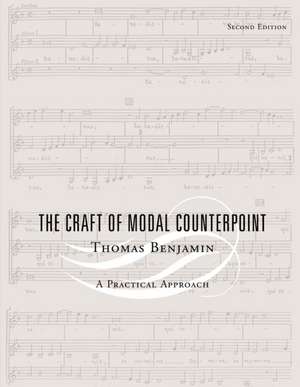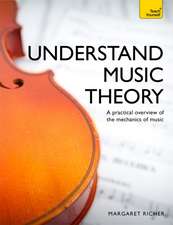The Craft of Modal Counterpoint
Autor Thomas Benjaminen Limba Engleză Paperback – 2005
Benjamin, a composer and pedagogue, offers a complete analysis of this important musical style. He begins by covering general aspects of the style, then covers in detail two, three, and four-part counterpoint. The Motet, an important form of vocal composition in this period, is studied separately. The book concludes with a brief anthology of key scores, 15 in all, for the student to study further. Also includes 132 musical examples.
Preț: 473.95 lei
Preț vechi: 557.58 lei
-15% Nou
Puncte Express: 711
Preț estimativ în valută:
90.69€ • 94.93$ • 75.48£
90.69€ • 94.93$ • 75.48£
Carte tipărită la comandă
Livrare economică 31 martie-14 aprilie
Preluare comenzi: 021 569.72.76
Specificații
ISBN-13: 9780415971720
ISBN-10: 0415971721
Pagini: 202
Ilustrații: 132 b/w images
Dimensiuni: 210 x 297 x 10 mm
Greutate: 0.5 kg
Ediția:Revizuită
Editura: Taylor & Francis
Colecția Routledge
Locul publicării:Oxford, United Kingdom
ISBN-10: 0415971721
Pagini: 202
Ilustrații: 132 b/w images
Dimensiuni: 210 x 297 x 10 mm
Greutate: 0.5 kg
Ediția:Revizuită
Editura: Taylor & Francis
Colecția Routledge
Locul publicării:Oxford, United Kingdom
Cuprins
1. General Stylistic Aspects
Texture
Text Setting
Notation and Performance Practice
Rhythm and Meter
Note Values
Rests
Dots and Ties
Harmony
General Observations
Accidentals (Musica ficta)
Cadences
Chords
Melody
General Observations
Intervals and Treatment of Leaps
Other Aspects of Melody
Typical Quarter-Note Idioms
2. Two-Voice Counterpoint
General Observations
Rhythm
Texture
Phrase and Form
Motivic (Thematic) Organization
Technical Details
Motion Relationships
Intervallic Relationships
Cadential Idioms
Comments on Two-Voice Composition
Imitation in Two-Voice Texture
General Observations
Invertible Counterpoint at the Octave
Invertible Counterpoint at the Twelfth
3. Three-Voice Counterpoint
General Observations
Texture and Rhythm
Harmony
Dissonance Treatment
Cadential Idioms
Imitation
Comments on Imitation
Comments on Three-Voice Composition
4. Counterpoint in Four Voices
5. The Motet
General Observations
Imitation
Comments on Motet Writing
Suggestions for Further Study
Appendix: An Anthology of Complete Works
Bibliography
Discography
Index
Texture
Text Setting
Notation and Performance Practice
Rhythm and Meter
Note Values
Rests
Dots and Ties
Harmony
General Observations
Accidentals (Musica ficta)
Cadences
Chords
Melody
General Observations
Intervals and Treatment of Leaps
Other Aspects of Melody
Typical Quarter-Note Idioms
2. Two-Voice Counterpoint
General Observations
Rhythm
Texture
Phrase and Form
Motivic (Thematic) Organization
Technical Details
Motion Relationships
Intervallic Relationships
Cadential Idioms
Comments on Two-Voice Composition
Imitation in Two-Voice Texture
General Observations
Invertible Counterpoint at the Octave
Invertible Counterpoint at the Twelfth
3. Three-Voice Counterpoint
General Observations
Texture and Rhythm
Harmony
Dissonance Treatment
Cadential Idioms
Imitation
Comments on Imitation
Comments on Three-Voice Composition
4. Counterpoint in Four Voices
5. The Motet
General Observations
Imitation
Comments on Motet Writing
Suggestions for Further Study
Appendix: An Anthology of Complete Works
Bibliography
Discography
Index
Recenzii
"Here, at last, is a book that dealt with the modal contrapuntal style in a musical and compositional way... the emphasis is always on the music itself and... on the craft of composing in this style. This is a very significant addition to the library of books on modal counterpoint." -- Dr. Robert Nelson, Professor of Music Theory and Composition, University of Houston
"The author is quite well-respected in the field, known as a composer but even more particularly as a teacher devoted to issues of effective pedagogy. This is a thoughtful and significant contribution to the study of Renaissance (or modal) counterpoint." -- Dr. Sharon G. Levy, Professor of Theory and Composition at Peabody Conservatory
"The author is quite well-respected in the field, known as a composer but even more particularly as a teacher devoted to issues of effective pedagogy. This is a thoughtful and significant contribution to the study of Renaissance (or modal) counterpoint." -- Dr. Sharon G. Levy, Professor of Theory and Composition at Peabody Conservatory









